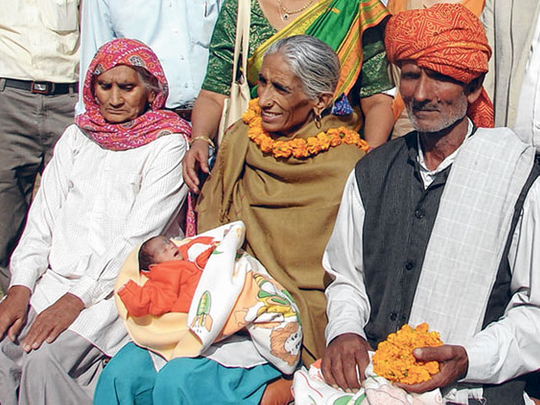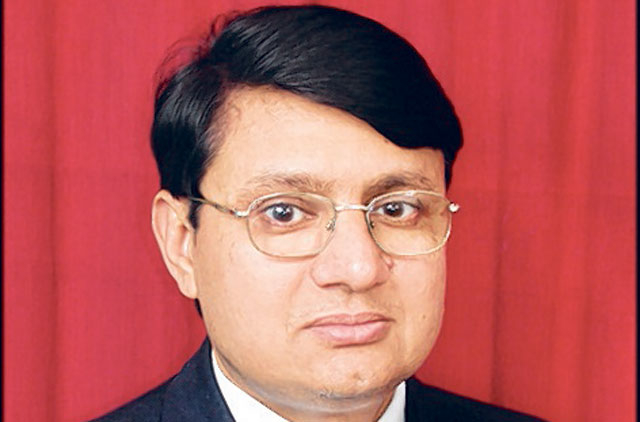
Just when he deserved to be felicitated, Dr Anurag Bishnoi is being accused of treating childless women in India as subjects for experiment. To Dr Bishnoi, chairman of the National Fertility & Test Tube Baby Centre in Hissar, Haryana, goes the credit for creating history in March 2009, when 70-year-old Rajo Devi Lohan became the oldest mother in the world.
Eighteen months later, another woman, Bhateri Devi, created a world record by bearing two boys and a girl. The 66-year-old has become the oldest woman to give birth to triplets after in vitro fertilisation (IVF) treatment.
Incidentally, both women received IVF treatment at Dr Bishnoi's centre, which may not have the best of environs but is certainly the most famous for its feats.
It may be recalled that the birth of the first test-tube child, Louise Brown, in July 1978, through the IVF technique invented by Robert G. Edwards and Patrick Steptoe, was a path-breaking answer to infertility. In retrospect, it is considered one of the most important medical advances of the last century. Indian scientists were not behind. India was the second country in the world after the United Kingdom to produce a test-tube baby in October 1978.
Dr Subhash Mukherjee and his team in Kolkata made this happen by using cryo-preserved embryo, whereas the British scientists had used the natural cycle. Thus the technique used by the Indian scientists at that time was even more advanced than their British counterparts.
No legal hurdles
The IVF method was periodically reviewed by different scientific committees and subsequently a number of clinics in Mumbai and Kolkata emerged triumphant in their IVF efforts, leading to the successful birth of children. Unfortunately, though India's medical culture emphasises on the mother's right to create life, there are no legal restrictions and no law governing fertility treatment. This has resulted in fertility clinics having mushroomed all over the country and a sizeable number of them have come up in rural areas, where childlessness is seen as a social stigma.
Unlike in the West, Indian doctors do not need to take into account a mother's age or the number of eggs that can be implanted. Therefore, fertility tourism is seeing a boom in the country, becoming a profitable industry pegged at $450 billion annually. While a complete IVF cycle at an urban clinic in India costs $5,500, in the United States the average cost is double that amount. The same treatment is available in Indian clinics in semi-urban or rural areas for $2,000. While cost is a big factor in drawing people from abroad, equally important is the lack of effective regulation in India. Whereas British clinics are licensed to implant only two embryos into the uterus in a single treatment, India allows six embryos at a time. So the chances of having a baby on the first go are much higher in India. But the danger with implanting so many embryos is multiple pregnancies, which significantly raises the probability of premature birth, low birth weight, stillborn babies or death in infancy.
Although doctors admit that these complications occur, they defend the practice, citing lack of technological perfection, in which case they do not have a choice and when they do, only one embryo would be transferred to have one child. Until then, the doctors feel patients should have the right to decide how many embryos they want transferred.
There is no precise estimate about the numbers of patients who come from overseas and how many of them are of Indian origin but they come with all their homework done before landing in India.
Another "advantage India" for childless couples from overseas is that there is neither any restriction on egg donation nor a dearth of egg donors or surrogate mothers. In foreign shores, there is an acute shortage of donors. Hence not only is the wait long but again, compared to India, the costs higher.
Fertility clinics report that the number of surrogate births in India has more than doubled in the past few years and they are performing a growing number of IVF treatments for many who prefer to keep it a secret. It could be seen as a win-win situation for both the donor and the patient as the issue of donorship is shrouded in secrecy and both parties remain strangers.
While doctors reason that it could be because of the social stigma of being a donor in a conservative Indian society, they maintain the women are married with children and come from lower middle-class families. The only reason they trade their eggs or become surrogate mothers is to earn money.
In Britain, since 2005, children conceived by a donor have the right to information about their genetic parents once they turn 18. But in India, children conceived using donor eggs, sperm or embryos have no such right. And the doctors insist that this is how it should be — the donors should remain anonymous.
According to a survey by the Indian Society for Assisted Reproduction (ISAR), there are more than 400 IVF clinics in the country, providing an estimated 30,000 Assisted Reproductive Technology (ART) procedures annually. In 2008, the Indian Council of Medical Research brought forward a draft Bill on ART to regulate procedures. Some of the proposals include:
- No ART to be performed on a woman under 21 years of age
- A woman over 45 cannot be a surrogate mother
- No woman to act as a surrogate for more than three successful live births in her life.
But women's health activists argue that it is aimed more at promoting a lucrative business than addressing health and ethical concerns.
While the Bill is yet to be tabled in the Indian Parliament, recent reports indicated that Rajo Devi, who is now 72 and lives in a village called Alewa in Haryana, is dying and confined to bed because of complications after her IVF pregnancy.
She is frail and unable to lift her child and unlikely to recover. Reportedly, since she and her husband are uneducated farmers, it is said that they did not understand the risk to women about having a baby at such an old age. Experts fear Bhateri Devi could suffer the same fate.
Dr Bishnoi dismissed such reports.
Speaking to Weekend Review, he said: "It isn't the women but the men who are behind these rumours. One needs to see the objective behind it. In a childless marriage, the blame is often put on the woman's infertility. This gives men the excuse to marry again and keep more than one wife. Not only are the relatives open to such ideas, even the village elders never object. The stigma of the family name dying if they do not produce a son as heir is still prevalent in most homes."
Dr Bishnoi couldn't be more correct. Overcoming the stigma of childlessness was more overpowering than the strange aberration of a 70-year-old woman giving birth to a child. The arrival of the child born to an elderly couple was a cause of celebration in the village and the party continued for a week after the mother and daughter came home. The villagers treated the baby as "God's gift".
In fact, such was the enthusiasm that Rajo Devi and her husband had even planned to have another child — a son. But both Rajo Devi's health and the requirement of huge finances became hurdles for their plans.
Similarly, Bhateri Devi and her husband Deva Singh are ecstatic. Their lives have changed and the villagers have been thronging their house congratulating them.
After giving birth to triplets, Bhateri Devi had said: "My family is now complete. Earlier not only my extended family but also the villagers taunted me for being barren. My husband too had lost interest in me and had married twice to have children."
But as fate would have it, Deva Singh's two other wives too were unable to bear children and left him. The family realised that the problem could be with him. But left with no choice, they carried on with the stigma and their lives. Life took a turn for Bhateri Devi on a chance visit for some ailment to Dr Bishnoi's clinic, where she discussed her misfortune with him. The doctor came to her rescue and put her on medication. Soon, the large, empty house owned by the couple was full of life. Once Bhateri Devi gave birth to triplets, she became the most loved person to her husband. Undoubtedly, the doctor is godsend for the families.
A safe treatment
Dr Bishnoi, who runs a private clinic in Hissar, inherited the practice from his parents. Together they have been researching the IVF technique and have been instrumental in 65 post-menopausal pregnancies. He claimed that all mothers were doing fine.
Asked if Rajo Devi's pregnancy at her age was responsible for her deteriorating health, Dr Bishnoi denied her illness was linked to her pregnancy. "For the past two years, she has been doing fine. She had an ovarian cyst that was causing her problems but that has now been removed. One can attribute her illness to old age, not to IVF treatment, which is completely safe."
Becoming parents is a great pleasure of life and thus procreation is considered a basic right. Unfortunately, millions of infertile couples who failed to procreate were, till some years back, deprived of this pleasure. But not any more. I respect women who opt for IVF to become mothers and get rid of the stigma of infertility. Becoming pregnant at an advanced age has its hazards but these women are like soldiers who go to battle, not knowing whether they will come back alive.
The doctor added: "We are taking calculated risks to help people. Agreed that compared to a 40-year-old, a 70-year-old woman in such circumstances can be hypersensitive but they themselves are willing to bear children. To them, everything is better than living with the shame of being childless. When heart surgeries can be done on elderly people, what's wrong in having children through IVF?"
As a defender of the patients' rights, he said these treatments were done in the interest of the women and their families. And as long as they can afford it, they have every right to decide what is best for them and there was no need for others to sit in judgment.
On whether there was need for regulation, Dr Bishnoi remarked: "Certain regulations are imperative. The government should allow only one centre in an area and it should be registered.
"Every IVF centre should have its own team to do IVF routinely, according to the menstrual cycle of the patient. But the usual ongoing practice is to invite outside teams, which dispose off large number of cases in one or two days. This is highly irresponsible and jeopardises the quality of expensive treatment. It is important that the government takes strict measures and issues guidelines for the awareness of the patients."
Dr Bishnoi said that, ethically, the IVF embryo transfer should be done in camps by advancing or postponing the menstrual cycle in women because the rate of maturity of eggs tends to be different in individuals. He cited examples of women, who, despite suffering failure through IVF treatment thrice, did not lose heart and approached his centre. The blastocyst culture technique was applied and only one embryo was transferred, which resulted in pregnancy and delivery of a healthy child. It means IVF failure for two or three times should not stop doctors from continuing their efforts.
Freed from stigma
For Rajo Devi, the miracle happened after 55 years of marriage. Overnight, she and her husband became stars.
She said: "I have no regrets. All my life I desired to have a child. It does not matter to me that I am ill, because I lived to become a mother. At least now I will die in peace and not suffer the taunts of being childless."
Desperate to have a child, the poverty-stricken couple had sold their cattle and taken loans to pay $2,000 for IVF treatment. But all this is nothing compared to the joy of hearing "Ma" from her child, who has been named Naveen. Although no different from the 25 million children born annually in India, Naveen is nothing short of an angel in the lives of the couple.
Rajo Devi said: "Before Naveen was born, I lived a life full of shame and anguish. We endured village gossip and people avoided us at festivals and social gatherings. In our culture, family means children. But being childless, I felt humiliated when ostracised by the very people we lived among. Some would even tell my husband to leave me."
The couple visited temples, went to local quacks and consumed all kinds of medicines but nothing worked. It was incidental that a villager told them about Dr Bishnoi and his clinic about 40 kilometres from their village. Ever since, they have been happy and Rajo Devi believes God will take care of their daughter.
But experts question the wisdom of doctors who they feel are endangering the lives of women by helping them give birth at an old age. Since older women generally require Caesareans, it is likely to be dangerous for them.
Divulging facts about IVF treatment in India
Scientist Dr R.S. Sharma, deputy director-general, Indian Council of Medical Research on IVF treatment in India:
Should there be an age limit for receiving IVF in India?
Under the provision made in the draft Assisted Reproductive Technology (Regulation) Bill, 2010, the minimum age for receiving IVF in India is 21 years whereas there is no upper age limit.
Women activists feel this may endanger the lives of elderly woman who are uneducated and do not realise the risk to their lives.
Considering procreation a fundamental right, the drafting committee did not recommend an upper age limit.
Which major points were looked into while preparing the draft Bill?
It is estimated that 15 per cent couples around the world are infertile, which implies that infertility is one of the most prevalent medical problems. This issue has enormous social implications. Besides the fact that every couple has the right to have a child, in India infertility widely carries with it a social stigma. In the Indian context, children are also a kind of old-age insurance.
What regulations are needed to protect the rights of the patients?
The ART technique has made it possible for women to conceive, thus enhancing the possibilities of parenthood. But the desire to have children by childless couples is so great that many infertility clinics have mushroomed all over the country. However, the quality of services offered by some of these clinics is highly questionable.
In the past two decades there has been an exponential growth of infertility clinics that use techniques requiring handling of spermatozoa or the oocyte outside the body, or the use of a surrogate mother. These technologies require immense expertise. But since no permission is required and there are no norms, it has opened up avenues for unethical practices, which can adversely affect the recipient of the treatment — medically, socially and legally. The infertility clinics are required to maintain a high standard of services to achieve a reasonably good success rate and remain ethical. It is in the interest of the public that regulations are put in place to protect their rights.












